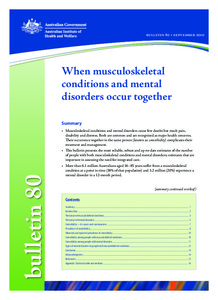When musculoskeletal conditions and mental disorders occur together
"Musculoskeletal conditions and mental disorders cause few deaths but much pain, disability and distress. Both are common and are recognised as major health concerns. Their occurrence together in the same person (known as comorbidity) complicates their treatment and management. This bulletin pr...
| Main Author: | |
|---|---|
| Institution: | ETUI-European Trade Union Institute |
| Format: | TEXT |
| Language: | English |
| Published: |
Canberra
2010
AIHW |
| Subjects: | |
| Online Access: | https://www.labourline.org/KENTIKA-19183331124919015139-When-musculoskeletal-condition.htm |
| _version_ | 1771659892738752513 |
|---|---|
| author | Australia. Australian Institute of Health and Welfare |
| author_facet | Australia. Australian Institute of Health and Welfare |
| collection | Library items |
| description | "Musculoskeletal conditions and mental disorders cause few deaths but much pain, disability and distress. Both are common and are recognised as major health concerns. Their occurrence together in the same person (known as comorbidity) complicates their treatment and management. This bulletin presents the most reliable, robust and up-to-date estimates of the number of people with both musculoskeletal conditions and mental disorders; estimates that are important in assessing the need for integrated care.
More than 6.1 million Australians aged 16–85 years suffer from a musculoskeletal condition at a point in time (38% of that population) and 3.2 million (20%) experience a mental disorder in a 12-month period. Over 1.5 million people (10% of Australians aged 16–85 years) had at least one musculoskeletal condition and one mental disorder in the preceding 12 months. The number of females experiencing this comorbidity (862,000) was greater than the number of males (671,000).The extent of comorbidity increased sharply in each successive age group until 45–54 years, after which it decreased sharply. There were 470,000 more Australians who had both a musculoskeletal condition and a mental disorder in 2007 than would be expected if occurrences of the two conditions were independent of one another.
Published studies suggest that causal pathways are more likely to be from musculoskeletal conditions to mental disorders than the reverse, although the latter can also occur. Overall, in 2007, 25% of people with a musculoskeletal condition also had a mental disorder, the most common of which were anxiety disorders. The clear association between musculoskeletal conditions and mental disorders found in this study emphasises the need for health-care providers to be aware of and provide for a multidisciplinary approach to the management of this comorbidity." |
| format | TEXT |
| geographic | Australia |
| id | 19183331124919015139_bab1b542b91543f7913ea6e40a82ed52 |
| institution | ETUI-European Trade Union Institute |
| is_hierarchy_id | 19183331124919015139_bab1b542b91543f7913ea6e40a82ed52 |
| is_hierarchy_title | When musculoskeletal conditions and mental disorders occur together |
| language | English |
| physical | 18 p. Digital |
| publishDate | 2010 |
| publisher | Canberra AIHW |
| spellingShingle | Australia. Australian Institute of Health and Welfare health policy mental disorders musculoskeletal diseases statistics When musculoskeletal conditions and mental disorders occur together |
| thumbnail | https://www.labourline.org/Image_prev.jpg?Archive=115346893352 |
| title | When musculoskeletal conditions and mental disorders occur together |
| topic | health policy mental disorders musculoskeletal diseases statistics |
| url | https://www.labourline.org/KENTIKA-19183331124919015139-When-musculoskeletal-condition.htm |

